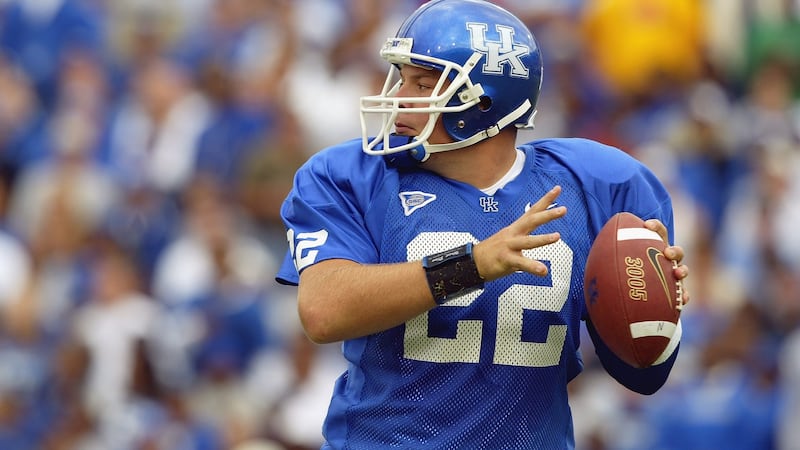In the last act of his sporting career, Jared Lorenzen rolled out of the huddle, ball snug in his left hand, where it had always been, through high school, college and the pros. As he surveyed the options downfield, he noticed a lineman converging fast so he told himself it was time to get low and brace for impact. His brain was writing a cheque his body, a six foot four chassis now struggling to carry 25 stone, could no longer cash. He bore the hit full on, broke a tibia, and tore ankle ligaments. Four men were required to lift him from the unforgiving concrete abutting the sideline.
“We’re praying for you boy,” shouted his team-mates as he was carted away.
He was a Northern Kentucky River Monster by then, playing off-off-Broadway in a sparsely-attended, indoor minor league yet enough of his celebrity lingered in 2014 for the injury to make national news. It wasn’t just that he had once set passing records at the University of Kentucky or served as back-up to the New York Giants’ Eli Manning during Super Bowl XLII, the 32-year-old had turned into an internet sensation just the previous week. Footage of him evading tackles with some nifty footwork in the River Monsters’ season opener went viral because the fabric of his jersey visibly strained to contain the undulating hills of his sprawling upper body.
Overweight
The Hefty Lefty. J Load. The Pilsbury Throwboy. The round mound of touchdown. A slew of nicknames (some of which he relished) that had followed him throughout his career, each glorifying the fact he was overweight even in his athletic prime (21 stone when cut by the Indianapolis Colts in 2008), were trotted out for a fresh airing. Everybody likes to snigger at an out of shape athlete gone to seed. The laughing and the jeering only stopped a couple of years later when news emerged Lorenzen had tipped the scales at 40 stone and 7lbs and was in a fight for his life. He lost that battle on July 3rd of this year, the official cause of death an infection complicated by heart and kidney issues.
He was 13lbs and 3 ounces at birth. At four he lay down on the grass during a soccer match in protest at how much running was required. Shortly after that they discovered he had a gun for a left arm. As a teenager, one coach would coerce and cajole him into getting into shape for the grid-iron season then reward his diligence with an enormous plate of brownies for doing so. In college, a student trainer was sent to live with him to enforce dietary restrictions. Within three months, the trainer had put on 10lbs.
When Lorenzen’s girlfriend and future wife Tamara gave birth to Taylar, a daughter, just before his senior year, he told reporters; “I have to feed her at 9 and 11 and 1 and 3 and 5. It doesn’t bother me because that’s my feeding schedule too.”

By the time he made the pros, the New York Giants' Tom Coughlin was fining players $400 for each pound they were over their prescribed playing weight on Friday morning. Lorenzen spent his Thursdays using a frantic combination of sauna, spitting and starvation to try to save money. That he was in the NFL at all spoke to how much talent he possessed in a prodigious left arm that threw for 10,354 yards and 78 touchdowns in college. There are 32 starting quarterbacks and 32 back-ups in the league each season and to make that elite grouping for several campaigns requires preternatural ability and application.
In the build-up to the Super Bowl, Lorenzen played the role of a quasi-defensive back in training, constantly harassing Manning. The pivotal moment in the famous victory over the Patriots involved the Giants' quarterback miraculously escaping a tackle before unfurling a pass to David Tyree. Aside from his footnote in history as the heaviest quarterback ever to take a down in the NFL, Lorenzen's key involvement in preparing Manning for that play was mentioned a lot in the obituaries following his passing last month. All too, of course, touched upon his lengthy and very public struggle with his weight.
Since leaving the NFL, he worked in sales for a plumbing company and an office-supplies outfit, started a T-shirt company with some friends, and coached his son’s pee-wee football team. In 2017, he launched “The Jared Lorenzen Project”, chronicling with videos on Facebook his first concerted effort to finally grapple with an issue that was slowly killing him. Supported by doctors, nutritionists and trainers, and supportive shout-outs from former team-mates like Manning, he shed more than eight stone in the first 12 months. The portrait, for a time, was of a man on the way back. Then, the positive updates stopped coming.
"He has trouble sleeping, and his snoring just about cracks the drywall," wrote Tommy Tomlinson, a journalist who has since produced a moving memoir about his own battle with obesity, in the definitive piece on Lorenzen for ESPN The Magazine back in 2014. "Stairs are starting to give him a problem, especially with his leg still healing. We see our futures, and they're not long ones. I'm 50, and I might feel it more deeply than he does. Nobody who's 65 looks like we do."
Jared Lorenzen died at 38.















